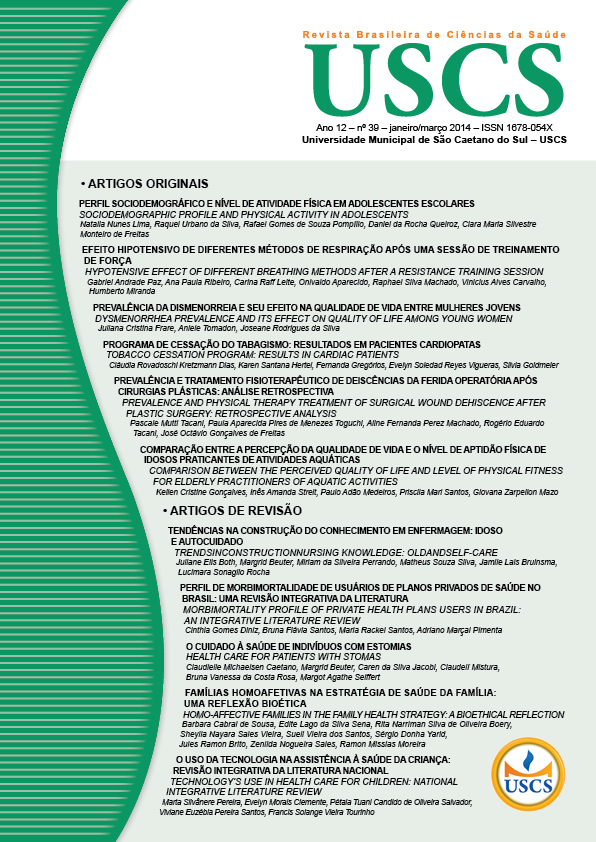EFEITO HIPOTENSIVO ATRAVÉS DE DIFERENTES MÉTODOS DE RESPIRAÇÃO APÓS UMA SESSÃO DE TREINAMENTO DE FORÇA
DOI:
https://doi.org/10.13037/rbcs.vol12n39.2011Keywords:
Educação Física, Exercícios resistidos, Pressão arterial, hemodinâmicaAbstract
Introdução: O tipo de respiração adotado durante exercícios resistidos pode influenciar em modificações na pressão arterial. Objetivo: Comparar o efeito da respiração ativa (RA) e respiração passiva (RP) sobre a pressão arterial sistólica (PAS) e diastólica (PAD) após uma sessão de treinamento de força (TF). Materiais e métodos: Treze homens (25 ± 3,3 anos, 186 ± 4,1 cm, 72,1 ± 5,9kg e 25,1 ± 3,1 kg/m2 de índice de massa corporal) com experiência prévia em TF (2 ± 1,1 anos) participaram do estudo. Inicialmente foi realizado o teste de 1 repetição máxima (RM) nos exercícios supino inclinado articulado, cadeira extensora, puxador articulado, cadeira flexora e desenvolvimento articulado. Em seguida, foram realizadas duas sessões de TF através de entrada alternada (48h de intervalo), adotando-se dois tipos de respiração (RA e RP), para tal os indivíduos realizaram três series de 10 repetições (80% de 1RM) com um minuto de intervalo entre séries e exercícios. Resultados: Não foi observada diferença significativa nos valores de PAD e PAS entre os dois tipos de respiração após as sessões de TF nos intervalos de 5, 10, 15, 20, 25 e 30 minutos, todavia, verificou-se redução significativa nos valores de PAS e PAD de 15 a 25 minutos após a sessão TF comparado aos valores de repouso em ambos os protocolos. Conclusão: Uma sessão de TF com volume equalizado para membro superior e inferior parece não sofrer interferência do tipo de respiração (RA ou RP) sobre o comportamento da PAD e PAS.Downloads
Downloads
Published
2014-02-27
Issue
Section
ARTIGOS ORIGINAIS
License
Policy Proposal for Journals offering Free Delayed Access
Authors who publish in this magazine agree to the following terms:
- Authors maintain the copyright and grant the journal the right to the first publication, with the work simultaneously licensed under a Creative Commons Attribution License after publication, allowing the sharing of the work with recognition of the authorship of the work and initial publication in this journal.
- Authors are authorized to assume additional contracts separately, for non-exclusive distribution of the version of the work published in this magazine (eg, publishing in institutional repository or as a book chapter), with the acknowledgment of the authorship and initial publication in this journal.
- Authors are allowed and encouraged to publish and distribute their work online (eg in institutional repositories or on their personal page) at any point before or during the editorial process, as this can generate productive changes, as well as increase impact and citation of the published work (See The Effect of Open Access).









